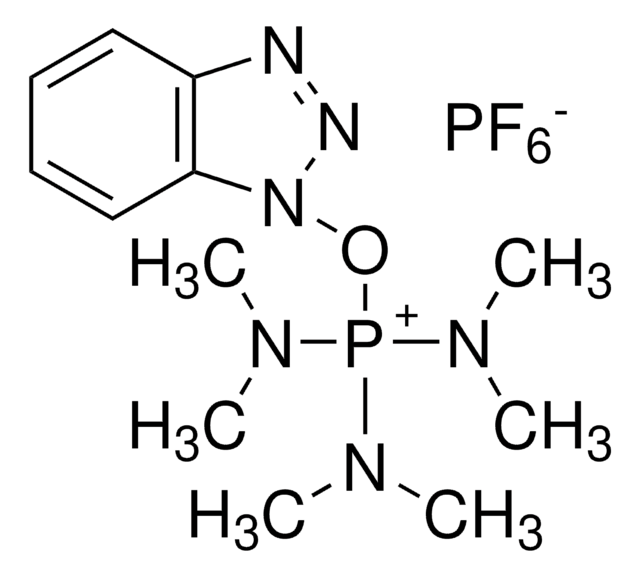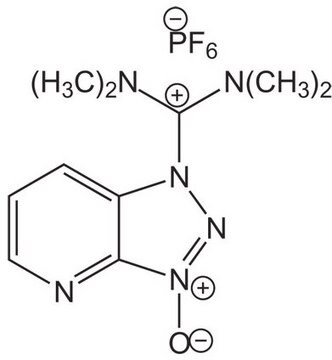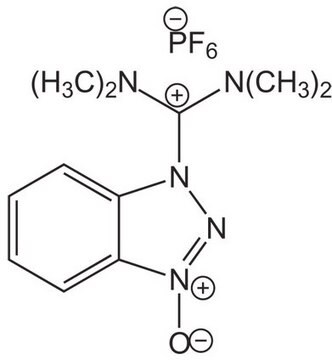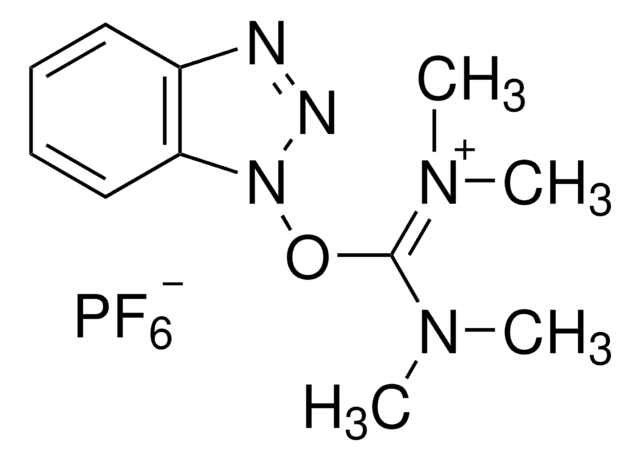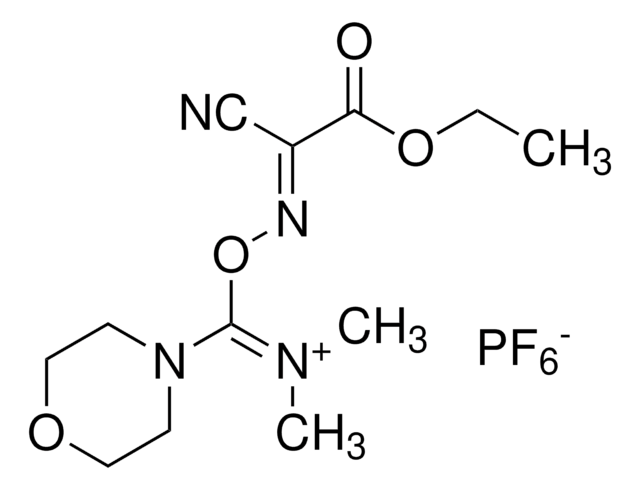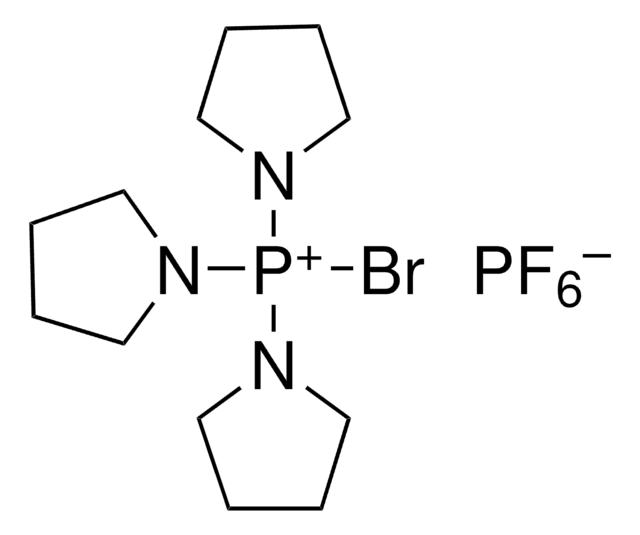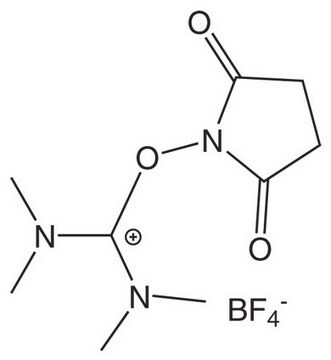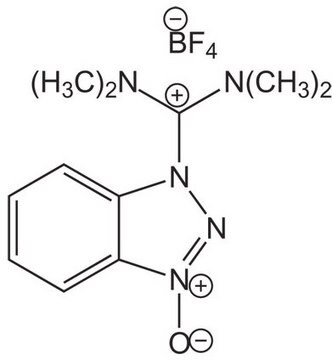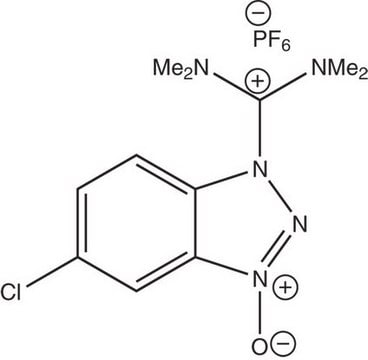8.51004
BOP
Benzotriazole-1-yl-oxy-tris-(dimethylamino)-phosphonium hexafluorophosphate Novabiochem®
Sinónimos:
BOP, Benzotriazole-1-yl-oxy-tris-(dimethylamino)-phosphoniumhexafluorophosphate, Castro′s Reagent
About This Item
Productos recomendados
Nivel de calidad
Línea del producto
Novabiochem®
Análisis
≥99.0% (HPLC)
formulario
powder
idoneidad de la reacción
reaction type: Coupling Reactions
fabricante / nombre comercial
Novabiochem®
mp
138-145 °C
aplicaciones
peptide synthesis
temp. de almacenamiento
2-8°C
InChI
1S/C12H22N6OP.F6P/c1-15(2)20(16(3)4,17(5)6)19-18-12-10-8-7-9-11(12)13-14-18;1-7(2,3,4,5)6/h7-10H,1-6H3;/q+1;-1
Clave InChI
MGEVGECQZUIPSV-UHFFFAOYSA-N
Descripción general
Associated Protocols and Technical Articles
Guide to Selection of Coupling Reagents Literature references
[1] B. Castro, et al. (1975) Tetrahedron Lett., 16, 1219.
[2] B. Castro, et al. (1976) Synthesis, 751.
[3] B. Castro, et al. (1977) Synthesis, 413.
[4] B. Castro, et al. (1977) J. Chem. Res. (S), 182.
[5] P. Rivaille, et al. (1980) Tetrahedron, 36, 3413.
[6] D. L. Nguyen, et al. (1985) J. Chem. Soc., Perkin Trans. 1, 1025.
[7] D. L. Nguyen, et al. (1987) J. Chem. Soc., Perkin Trans. 1, 1915.
[8] A. Fournier, et al. (1988) Int. J. Peptide Protein Res., 31, 86 and 231.
[9] J.-P. Briand, et al. (1989) Pept. Res., 2, 381.
[10] A. Fournier, et al. (1989) Int. J. Peptide Protein Res., 33, 133.
[11] D. L. Nguyen, et al. (1989) Biochem. Biophys. Res. Commun., 162, 1425.
[12] W. K. Rule, et al. in ′Peptides 1988, Proc. 20th European Peptide Symposium′, G. Jung & E. Bayer (Eds), Walter de Gruyter, Berlin, 1989, pp. 238.
[13] M. Forest, et al. (1990) Int. J. Peptide Protein Res., 35, 89.
[14] R. Seyer, et al. (1990) Int. J. Peptide Protein Res., 35, 465.
[15] H. Gausepohl, et al. in ′Innovation & Perspectives in Solid Phase Synthesis, 2nd International Symposium′, R. Epton (Eds), Intercept UK Ltd., Andover, 1993, pp. 387.
[16] R. P. McGeary (1998) Tetrahedron Lett., 39, 3319.
Ligadura / enlace
Nota de análisis
Appearance of substance (visual): powder
Identity (IR): passes test
Assay (HPLC, area%): ≥ 99.0 % (a/a)
Solubility (0.6 mmole in 1 ml DMF): clearly soluble
Información legal
Palabra de señalización
Danger
Frases de peligro
Consejos de prudencia
Clasificaciones de peligro
Flam. Sol. 1 - Skin Irrit. 2 - STOT SE 3
Órganos de actuación
Respiratory system
Riesgos supl.
Código de clase de almacenamiento
4.1A - Other explosive hazardous materials
Clase de riesgo para el agua (WGK)
WGK 3
Punto de inflamabilidad (°F)
Not applicable
Punto de inflamabilidad (°C)
Not applicable
Certificados de análisis (COA)
Busque Certificados de análisis (COA) introduciendo el número de lote del producto. Los números de lote se encuentran en la etiqueta del producto después de las palabras «Lot» o «Batch»
¿Ya tiene este producto?
Encuentre la documentación para los productos que ha comprado recientemente en la Biblioteca de documentos.
Los clientes también vieron
Artículos
Novabiochem® offers a large number of coupling reagents for in situ activation. In situ activating reagents are easy to use, fast reacting – even with sterically hindered amino acids, and their use is generally free of side reactions.
Nuestro equipo de científicos tiene experiencia en todas las áreas de investigación: Ciencias de la vida, Ciencia de los materiales, Síntesis química, Cromatografía, Analítica y muchas otras.
Póngase en contacto con el Servicio técnico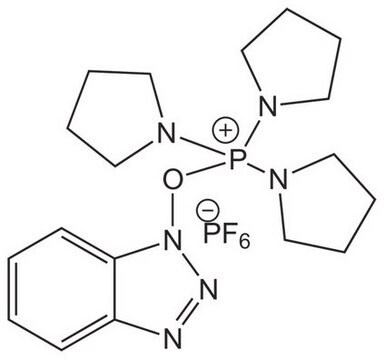
![COMU 1-[(1-(Cyano-2-ethoxy-2-oxoethylideneaminooxy) dimethylaminomorpholino)] uronium hexafluorophosphate Novabiochem®](/deepweb/assets/sigmaaldrich/product/images/237/337/13566c06-8931-4cc2-8621-c8742a392cd6/640/13566c06-8931-4cc2-8621-c8742a392cd6.jpg)

